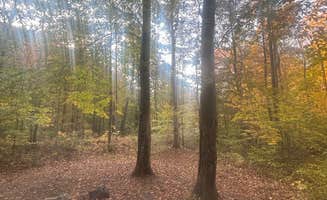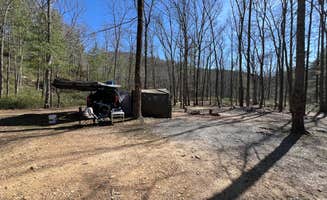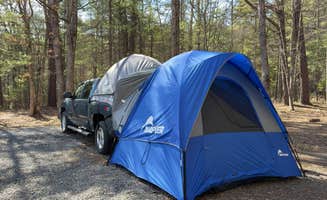Primitive camping near Cloverdale, Virginia concentrates within the George Washington National Forest, an area covering over 1 million acres with elevations ranging from 1,000 to 4,000 feet. This region experiences four distinct seasons with spring and fall typically offering the most moderate temperatures for backcountry camping. Winter temperatures can drop well below freezing while summer brings humidity and temperatures averaging in the mid-80s.
What to do
Hiking to scenic overlooks: Campers staying at Johns Spring Shelter can access McAfee Knob, one of the most photographed spots on the Appalachian Trail. "This spot is really awesome. It can also just be done as a day hike, so I recommend it to anyone who doesn't mind a 8ish mile hike," notes Sam M. The area also offers bouldering opportunities near the summit.
Creek-side relaxation: Many sites in the national forest feature small streams perfect for wading or filtering water. At Reservoir Road Dispersed Campsite, visitors can enjoy the Pedlar River. Derek D. confirms there are "multiple spots along reservoir rd" where campers can set up near the water.
Trail connectivity: Several dispersed sites connect to longer trail networks. "There is a hike at the end of the road that takes you to a gorgeous summit and links to AT!" says Kelly K. about camping in the forest. This connectivity allows for day hikes or longer backpacking trips directly from camp.
What campers like
Solitude and seclusion: Many primitive sites in the area offer privacy from other campers. "I didn't see anyone else near this site when I stayed," shares Ryan L. about his experience at George Washington National Forest off 812. The remoteness attracts those seeking quiet experiences away from crowds.
Natural water features: Creek-side camping ranks among the most appreciated aspects of dispersed sites. "We had the absolute best time. It was so peaceful being by the creek and just relaxing," reports Kenlei B. about their anniversary trip. These water sources provide both ambiance and practical utility for campers with filtration systems.
Established fire rings: Despite being primitive sites, many locations feature well-constructed fire pits. A camper at Dispersed Camping Site off FR 812 describes "a giant fire circle in the middle" with ample space for group camping. Some sites even have stone ovens constructed by previous visitors.
What you should know
Variable site availability: Arriving early improves chances of securing preferred sites. "Multiple road sites that fit my van with room to spare - 80% were full on a beautiful fall Friday evening around 6pm but still snagged one," reports SJ W. Weekends and fall foliage season see increased competition for spots.
Road conditions: Access roads can deteriorate with weather. Keith H. visited in May and found clean conditions, noting the "creek for water if you have filter. Nice fire ring and wood." However, Jon N. cautions about one site having "a very rocky path, about 50 feet long, to get into the campground, but then it is smooth and well laid out."
Limited facilities: No permanent facilities exist at these primitive sites. Mark M. describes finding unexpected camping opportunities: "Unexpectedly found this site after planning on doing some primitive camping off the road. There's 2 sites that I saw on the road with pits." Campers should prepare for complete self-sufficiency.
Tips for camping with families
Space considerations: Some dispersed sites accommodate groups better than others. David B. describes one location as having "large open space with several flat areas for tents. There are several spots on this road, maybe 6 but this is the furthest off the road." These larger areas work well for families needing multiple tents.
Water access: Sites with gentle creek access provide natural entertainment for children. Sarah and James H. found "a nice woodsy campsite close to Natural Bridge" with a site that was "nice and flat, backed up to a little creek and had an established stone fire ring." These water features can engage children while adults set up camp.
Trail difficulty assessment: When hiking with children from camp, consider trail difficulty. Lucy P. notes that Johns Spring Shelter is "pretty basic, except for the lack of a good water source." Parents should research water availability and trail conditions before embarking on hikes with children.
Tips from RVers
Size limitations: Most dispersed sites accommodate only smaller recreational vehicles. Michael C. advises that if someone has taken the main site, "you could park next to them and ask if its cool to set up a little into the woods." This flexibility helps when primary spots are occupied.
Road clearance requirements: High-clearance vehicles fare better on forest roads. Sawyer B. found "awesome sites next to creek" but notes arrival timing matters: "Showed up around 5pm and were the only ones there." Low clearance vehicles risk damage on rougher sections of forest roads.
Seasonal conditions: Weather significantly impacts road accessibility. Jon N. mentions "no cell service (T-Mobile), but if I drove towards the main road, Route 501, I could get some service." This isolation increases safety concerns during inclement weather, particularly for larger vehicles with limited turning options.





